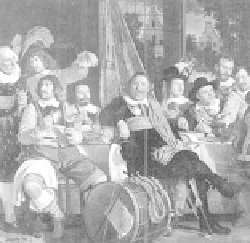Travel Reference
In-Depth Information
1600s—Holland's Golden Age
Holland gains its independence from
the Habsburgs (officially in 1648), while
Belgium languishes under Spanish rule.
Amsterdam invents the global economy,
as its hardy sailors ply the open seas,
trading in Indonesian spices and South
American sugar. Establishing colonies
all over the world, they also conceive
the African slave trade. Their nautical
and capitalist skills combine to make
Amsterdam the world's wealthiest city.
Sights
• Amsterdam's Rijksmuseum and Haarlem's Frans Hals Mus-
eum—paintings by Rembrandt, Hals, Vermeer, and Steen
• Old townhouses and gables in Amsterdam's Jordaan neigh-
borhood and Red Light District
• Amsterdam's Begijnhof, Royal Palace, Westerkerk, and
Rembrandt's House
• Brussels'
Manneken-Pis
• Lace (popularity peaks c. 1700)
1700s—Elegant Decline
Holland and Belgium are both sur-
passed by the rise of superpowers
France and England. Wars with those
powers drain their economies and
scuttle Holland's fleet. Still, they sur-
vive as bankers, small manufacturers,
and craftsmen in luxury goods—but
on a small scale fitting their geo-
graphical size. They hit rock-bottom
in 1795, when French troops occupy
the Low Countries (1795-1815), and
Europe's powers subsequently saddle
them with a monarchy.
Sights
• Amsterdam's Amstelkring Museum (hidden church), Willet-
Holthuysen Museum (Herengracht Canal Mansion), and
Jewish Historical Museum synagogue
• Brussels' Grand Place guildhalls





















